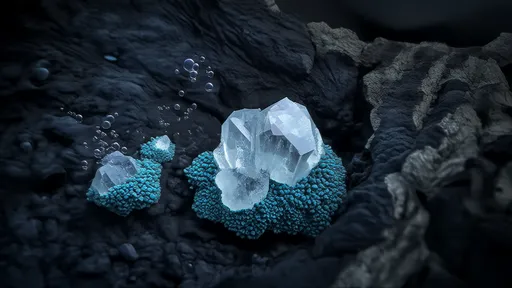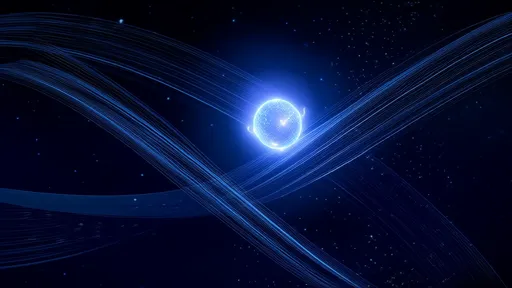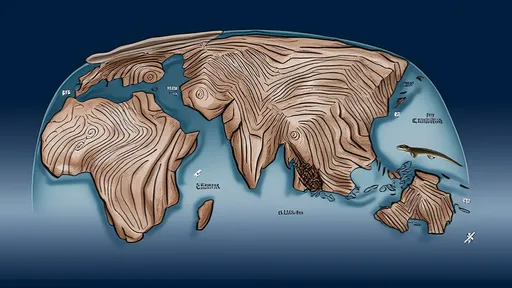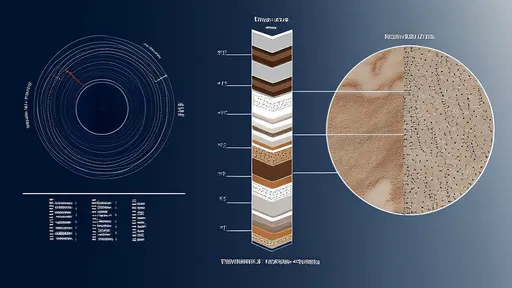The Earth's magnetic field, an invisible shield protecting our planet from solar radiation, has a history far more dynamic than its present-day stability suggests. Paleomagnetic records reveal a startling truth: the geomagnetic poles have reversed hundreds of times throughout Earth's history, with these flips preserved in the frozen magnetism of ancient rocks. This phenomenon, known as geomagnetic reversal, forms the backbone of magnetostratigraphy—a powerful tool for dating geological formations and unraveling Earth's deep-time narrative.
Deciphering the Magnetic Archives
When volcanic rocks cool or sediments settle, tiny magnetic minerals within them align with Earth's magnetic field, effectively fossilizing the field's orientation at that moment in time. These natural compasses, locked in place for millions of years, allow geophysicists to reconstruct past field behavior. The most striking pattern to emerge from this magnetic detective work is the repeated flipping of polarity, where north becomes south and vice versa. These reversals aren't instantaneous events but complex processes spanning thousands of years, during which the field weakens and becomes multipolar before reorganizing in the opposite orientation.
The development of magnetostratigraphy as a dating method relied on creating a standardized timeline of these reversals. Through painstaking analysis of oceanic crust and continental lava flows worldwide, researchers pieced together the Geomagnetic Polarity Time Scale (GPTS). This chronological sequence serves as a global benchmark, with each polarity interval—ranging from tens of thousands to millions of years—acting as a unique timestamp in Earth's geological record.
The Pulse of the Planet
Earth's magnetic field appears to reverse at irregular intervals, with no discernible periodicity. The last major reversal, the Brunhes-Matuyama event, occurred approximately 780,000 years ago. Prior to that, the field maintained its current "normal" polarity for an unusually long period—we're currently in what scientists call a "superchron," an extended interval between reversals that has persisted for nearly twice the average duration. The causes behind these flip-flops remain debated, though most theories point to complex fluid dynamics within Earth's outer core, where the geodynamo generates our magnetic field.
Modern observations show the field is currently weakening at an accelerated rate, particularly in the South Atlantic Anomaly—a vast region where the field strength has decreased by about 15% since systematic measurements began in 1840. While some interpret this as potential early signs of an impending reversal, the timescales involved mean such an event wouldn't pose an immediate threat to modern civilization. The geological record shows most reversals take 1,000-10,000 years to complete, with the field never fully disappearing during the process.
Reading the Magnetic Tapestry
Magnetostratigraphy's true power lies in its ability to correlate rock sequences across vast distances. When combined with radiometric dating and fossil evidence, magnetic reversals create an unparalleled chronological framework. A classic example is the correlation between oceanic magnetic anomalies and continental lava flows that helped confirm plate tectonic theory. As magma emerges at mid-ocean ridges and cools, it records the prevailing magnetic field, creating symmetrical stripes of alternating polarity that mirror the GPTS.
This technique has revolutionized our understanding of geological timescales. In the Neogene period alone, detailed magnetic stratigraphy has allowed scientists to date events with precision previously unimaginable—resolving timing differences of just a few thousand years in rocks millions of years old. Such resolution is crucial for understanding rapid climate shifts, evolutionary events, and catastrophic occurrences like meteorite impacts or massive volcanic eruptions.
Challenges in the Magnetic Record
Despite its utility, magnetostratigraphy faces several limitations. Not all rock types preserve magnetic signatures equally well—sedimentary rocks are particularly prone to remagnetization or weak initial signals. Additionally, the method relies on having well-dated reference sections; without absolute age constraints from radiometric dating or biostratigraphy, a magnetic reversal sequence could correspond to multiple time periods in the GPTS.
Researchers continue refining the technique through innovative approaches. New high-resolution paleomagnetic studies of layered sediments are revealing previously undetected short-lived reversal events called "excursions"—aborted reversals where the field begins to flip but then snaps back to its original orientation. These discoveries suggest Earth's magnetic behavior may be even more complex than current models indicate.
The Future of Magnetic Timekeeping
As analytical techniques improve, magnetostratigraphy is finding applications beyond traditional geological dating. Archaeologists now use magnetic signatures in fired clay artifacts to date ancient human settlements. Climate scientists correlate magnetic variations with paleoclimatic data to understand how geomagnetic changes might influence atmospheric processes. Even planetary scientists apply these principles to study the magnetic histories of other worlds, particularly Mars, where remnant magnetism in crustal rocks hints at a once-active dynamo now extinct.
The coming decades will likely see magnetostratigraphy integrated with emerging technologies like machine learning algorithms that can detect subtle magnetic patterns humans might overlook. Combined with advances in rock magnetism theory and more precise dating methods, we stand on the verge of reading Earth's magnetic autobiography with unprecedented clarity—revealing not just when the field reversed, but how these extraordinary events shaped our planet's geological and biological evolution.

By /Jun 19, 2025

By /Jun 19, 2025

By /Jun 19, 2025

By /Jun 19, 2025

By /Jun 19, 2025

By /Jun 19, 2025

By /Jun 19, 2025

By /Jun 19, 2025

By /Jun 19, 2025

By /Jun 19, 2025

By /Jun 19, 2025

By /Jun 19, 2025

By /Jun 19, 2025

By /Jun 19, 2025

By /Jun 19, 2025

By /Jun 19, 2025

By /Jun 19, 2025